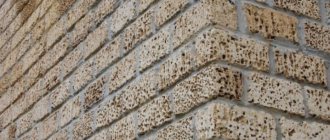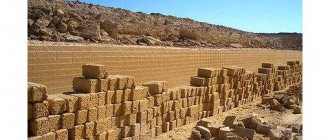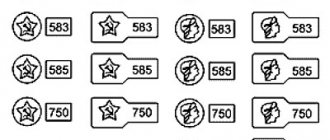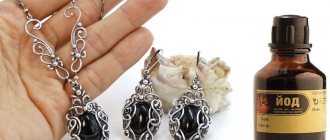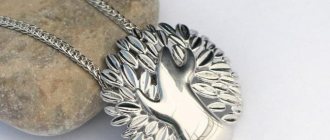Shell rock is a special material, its unique properties - regulating the microclimate in the house and saturating the air with sea salt and iodine - are due to its absolutely natural origin and absolute naturalness. The share of human participation in the production of shell rock is limited only to cutting the stone into pieces of the required sizes. The only effect on shell rock is hydrophobization.
Main technical characteristics of shell rock
Density is the main indicator; strength, weight, and durability directly depend on density. The range is from 750 to 2300 kg/m3, and depends on the location of production. The “weakest” shell rock is comparable in density to raw wood, and the strongest is comparable to heavy concrete!
The blocks are cut in standard sizes, although any sizes are possible - made to order. Standard - 380*190*188, weight from 10 to 25 kg, depending on the brand.
The lightest block M15 has a compressive strength of 15 kgf/cm2 and is used for one-story houses, garages, bathhouses and any outbuildings, and small forms of improvement. M25 is quite suitable for load-bearing walls of a two-story house. Brand M35 - used even for the basement parts of foundations and basement walls, with mandatory horizontal and vertical waterproofing.
The frost resistance of shell rock is no lower than that of red ceramic brick - on average 50 freeze-thaw cycles. And shell concrete is 1.5-2 times more frost-resistant than cellular concrete.
If you do not protect the shell from water and moisture, it will absorb water - up to 15-17% by volume. External plaster or cladding is necessary, or during the rainy season, shell rock can contribute to dampness in the house.
The temperature resistance of shell rock is low, slightly greater than that of aerated concrete, and it is not suitable for lining chimneys.
Ecology is one of the main advantages of natural stone. Being a sedimentary rock of bottom sediments, the shell does not contain harmful impurities; on the contrary, it releases beneficial iodine and salts into the room. This plus can be reduced by insulating the shell walls with polystyrene foam. Mineral and stone wools are mainly used as insulation.
The geometry of shell blocks leaves much to be desired. The actual size usually differs from the declared one by 20-30 mm, if not more. For this reason, many builders prefer blocks made of cellular concrete, ceramic blocks and brick. There are reasons - laying shell rock really takes a lot of mortar, and plastering uneven walls also takes a lot of over-expenditure.
The cost of shells is low only in the quarry after cutting, and delivery throughout Russia is very expensive, especially to the northern regions. A threefold rise in price may reduce interest in this unique building material, and this is understandable. It turns out to be more than twice as expensive as blocks made of gas silicate concrete. In addition, shell rock is fragile - especially M15 and M25, and it cannot be done without fighting in transport. Damage and chips during unloading are also not uncommon. For shell rock, they usually go to the mining site and solve all the issues there; at the same time, you can make sure of the quality of the material.
The porosity of shell rock varies greatly - from 25% to 70% (for low-grade ones). Shell walls provide excellent sound insulation and noise protection.
In terms of manufacturability, everything is excellent - you can saw, cut, drill and groove, pass communications. The weight of the blocks is from 12 to 26 kg; no mechanisms are needed during operation.
Application of shell rock
Thanks to its exceptional qualities, this natural stone is simply irreplaceable both in housing construction and for other purposes. But there are several nuances that you need to know. Due to the difference in density, strength, color, and structure of shell rock, when purchasing, you must inspect each block for through holes and check the brand of the product. It is easy to test the brand for impact: how hard the block will crack.
The weight of the block must be at least 16 kg to guarantee the necessary strength and density. The most extensive application, of course, is in the construction of houses. Blocks with an untreated sawn surface can be used in the construction of walls, fences, and arches. The low thermal conductivity of shell rock walls will provide the room with comfortable warmth in winter and refreshing coolness in summer. For areas with an average climate, a wall width of 40 cm is sufficient. This material is “breathable”, so excess moisture easily evaporates through it, the house is always dry and optimal air humidity is maintained. And this prevents the appearance of mold. Good sound insulation will not allow street noise to distract you from enjoying your holiday. The healing properties guarantee improved well-being and good mood.
Read more about shell rock construction
The strength and inertia of stone are the key to the longevity of the building. In history there are many architectural monuments built from shell rock and preserved in excellent condition to this day.
The porosity of the surface promotes strong adhesion to concrete, and the layer of mortar can be minimal, resulting in virtually seamless masonry. And this again has a positive effect on construction costs.
Thanks to the large size of the blocks, they are easy to work with: you don’t need the same skill as when working with bricks; you can do it yourself. It is enough to set the level correctly. It can be placed on any foundation; there are no special requirements for it.
Another plus in favor of shell rock: the block can be easily cut into pieces of the required sizes with a regular grinder with a circle of at least 180 mm. They will be required at the junction of walls and floor beams, in door and window openings.
Shell rock tiles are ideal for exterior finishing of facades. Light weight does not create additional load on the foundation. Its polished surface does not require additional processing.
Natural color harmonizes with the surrounding nature. Before facing the walls, they also do not require special preparation: the high degree of adhesion of shell rock to concrete guarantees reliable fastening to the facade and will hide its unevenness. Only for concrete mortar it is necessary to use fine river sand. If desired, the slabs can be easily painted in any color. The porous structure absorbs paint well and for a long time.
Polished slabs are also used in interior decoration, cladding of fireplaces and stoves. The ease of sawing allows you to give fireplaces any shape and shape. Low thermal conductivity will provide the outer surface of the block with pleasant warmth, despite the heat inside the fireplace.
In areas with high humidity, frequent rains, heavy snowfalls, after construction is completed, the walls must be treated with waterproofing agents, or clad in wood or brick with a gap for ventilation. You can also use mineral wool insulation or vapor-permeable plaster. If there is a road next to the house, then the facade can be treated with a special compound that prevents combustion products from settling. There are also means of protection against those who like to draw on the walls.
Various decorative items can be cut from shell rock: sculptures, flowerpots, various stands.
The unique pattern of shell curls on the cut will give the products elegance and lightness. By treating the surface with a protective composition, you can provide them, without exaggeration, with eternal life.
The rough (paving) surface of shell rock slabs is resistant to abrasion and is therefore used for cladding steps of stairs, porches, paths, and areas inside the yard. Where it is necessary to reduce or completely eliminate slipping.
Summarizing all of the above, shell rock is an excellent material for creating a beautiful, reliable and comfortable home for many years.
Features of shell masonry
In blocks depends on its size and vintage. The latter indicator can vary from M 15 to M 35. The number here means the compressive strength of the material. If the compressive strength is low, the material is not suitable for construction due to its fragility, and if it is too high, the house will be too cold due to the high density of the material. The best option would be blocks with medium density. They are also quite easy to work with: they can be cut using any hand tools.
Masonry from Crimean shell rock blocks can be done in three main ways:
- single-row;
- two-row;
- three-row.
In each case, ligation of the sutures must be done.
If a multi-row masonry method is used, it should alternate between spoon and bonded rows. Single-row masonry, in turn, is produced during the construction of a half-brick wall.
In all cases, especially close attention should be paid to the high-quality filling of vertical joints. In some cases, solutions for laying shell shells have to be poured into them from above
A high-quality masonry composition is an important component of successful construction.
You should never skimp when preparing it. And any mistake can be fatal. If you are not confident in your own abilities, do not take risks. Entrust the preparation of the solution to experienced, qualified specialists or purchase a ready-made mixture from a reliable manufacturer.
Shell rock is a natural material consisting of the shells of sea animals. The closest place of its extraction and production for Russia is Crimea. It was in the southern regions that it gained its popularity most of all.
Shell rock is a natural material consisting of the shells of sea animals.
Marble and limestone are also natural materials similar in composition to shell rock, but their density is much greater than the latter.
Shell rock is excellent for making walls of houses, barns, and foundations of various buildings.
Shell rocks are formed over hundreds of years under the influence of external conditions from mollusk shells settling on the bottom. When extracting it, the rocks are found to be red-brown, yellow or brown in color, which is easily deformed when sawed out. Despite the porous structure of shell rock, it is strong enough and suitable for the construction of even three-story buildings. Excellent sound insulation and thermal conductivity are attractive qualities of this material during the construction process. A house or building built from shell rock will never have an excess amount of moisture inside. This is explained by the fact that all its excess is removed through the porous walls of the shell rock.
The cost of a building built from this material is much lower than the cost of a brick one, this provides additional benefits to the owner. In addition, in private houses, attic floors are built from shell rock, since the attic should not be heavy.
Origin of shell rock
The main deposits of this natural stone are located in the southern regions, where prehistoric seas used to overflow: Moldova, Odessa region, Crimea, most of the Alps, Turkmenistan, Azerbaijan. As the name suggests, this building material consists of shells and shells from marine animals that lived in these seas. Over time, the seas dried up, the shores and bottom were exposed along with the remains of these sea creatures that settled in them. Even now, skeletons of these prehistoric animals can be found on sections of shell rock slabs. Under the influence of natural conditions and the severity of years, all this was compressed to the hardness of stone.
Composition and main characteristics of the material
Shell rock is limestone consisting of calcium salts. Moreover, regardless of the place of extraction, the composition remains approximately the same: calcium carbonate - 52.06-55.66%, magnesium oxide - 0.19-0.71%, carbon dioxide - 41.16-43.62%. Under the influence of acidic water, the calcium contained in the shells decomposes, releasing carbon dioxide. This determines the presence of pores in the structure of shell rock and the emergence of mineral springs. The main color is white-yellow, light yellow. Depending on the presence of impurities, the color may be different: iron gives pink shades to shell rock, copper – blue, coal – from gray to black.
Due to the fact that shell rock was formed in places of former seas and from the remains of marine animals, it releases vapors of iodine and sea salt and has good antibacterial properties. In a room decorated with this material, a specific composition of air appears, which strengthens the immune system and improves overall health. This especially helps people with cardiovascular diseases and those who have problems with the upper respiratory tract and the thyroid gland. Many resorts around the world are famous for their shell rock beaches with healing air.
Shell rock is a natural stone, therefore it is an environmentally friendly material. Compared to others, it has a neutral radiation background - 13 μg/h, with a minimum acceptable level of 25 μg/h. At the same time, it perfectly protects against dirty air, radiation and other harmful radiation by 100%. This is the only material capable of this.
Another very important advantage over other building materials is that mice and rats do not like a house made of shell rock. For a country house this is a significant indicator
The presence of pores is the reason for the low thermal conductivity of shell rock - 0.2-0.6 W/m-C°, while for brick it is 0.55-0.64, more than two times more. The situation is the same with sound insulation. Therefore, the use of this material eliminates the need to additionally insulate and protect the walls of the house from noise, which provides significant savings in construction. In addition, shell rock has very high frost resistance - up to 70 cycles, so you don’t have to worry about the integrity of the exterior decoration of the walls of the house, unless you go to change it yourself. Shell rock is very inert, therefore it does not react with other building materials, therefore, it will not collapse itself and will not subject other substances to deformation.
Based on their density, there are three types of shell rock:
M15 is the loosest, with large pores, and very loose in appearance. It comes in different colors - from white to brown, but most often yellow, for which it received the nickname “yellow”. The yellowish tint is given by the presence of sand impurities, which have a higher thermal conductivity compared to the shell rock itself. Therefore, this brand is the coldest among other brands. When hitting a hard surface, an M15 block breaks into several parts. In terms of weight, these blocks are the lightest (8-12 kg), so their surface may be damaged during loading and unloading operations. Subsequently, in order to level the surface, a large amount of plastering work may be required. Despite this, it is successfully used in the construction of garages, outbuildings, fences, bathhouses, and upper floors.
M25 is a shell rock with medium density and porosity. The main color is light yellow, sand. If dropped, it rarely breaks in half, and even less often into three parts. The most popular brand in construction, as it is superior in strength to brick, gas and foam concrete. Widely used for the construction of two-three-story houses. In frame and panel construction, interior partitions are made from this brand of shell rock. Block weight – 14-17 kg.
M35 is the densest and most durable grade of stone and has the lowest porosity. The color is almost white, yellow-white. The heaviest of all brands (22-25 kg), therefore ideal for laying foundations, basements, and ground floors. White shell rock is stronger than yellow shell rock.
Myths and Facts - PROS and CONS
Regardless of its origin, the exclusivity of SHELL ROCK is undeniable in terms of design attractiveness and architectural possibilities! This natural stone is used to create any architectural elements and implement even the most non-standard design solutions.
Not only that, the stone is absolutely unique in its technical characteristics! SHELL ROCK has a widely developed capillary system in its microstructure, which is filled with air. Thanks to this, the stone has high noise-reducing properties and minimal thermal conductivity, which allows you to save on expensive energy resources.
Radiation background
Of course, not 0 micrograms/hour. Everything that is on the surface of our planet has a natural radiation background. In Yekaterinburg, for example: it is 17 microns/hour. The natural radiation background of SHELL ROCK is 13 micrograms/hour. We can safely say that the background is, at a minimum, neutral. Although, according to the scale for measuring the radiation background of natural rock rocks, SHELL ROCK was assigned the number “0”.
Low thermal conductivity?
This is true. You can conduct an experiment at home: put a 20 mm thick shell rock slab on a gas burner and after a couple of minutes touch the back of the surface. The hand endures! This means no more than +50 degrees, although on the opposite side everything is +300!
Soundproofing?
Not hard to guess. The natural porosity of the material gives its results.
Can tiles come off the wall?
In no case! Unless, of course, this is not planned by the project! Due to its natural porosity, SHELL ROCK has increased adhesion! Stone is the best wall material for building houses using PERMANENT FORMWORK technology! Imagine, in addition to the wall frame, with proper stone processing, you get additional cladding on both sides!!!
Laying shell walls
First of all, to lay shell rock, masons will need a plastic masonry mortar. With a mortar that is too hard, it will be almost impossible to lay shell rock evenly even for experienced masons. A good masonry mortar should be easily pliable, but not flow.
The optimal composition of the mortar for laying the walls of a shell rock house is as follows:
- 1 bucket of PC-400 cement; - 4 buckets of sand; - approximately 1 bucket of water.
If you mix such a composition without additives to the mortar, it will be excessively hard and unsuitable for masonry. If you try to correct this by adding more water, the solution will quickly delaminate and lose the required plasticity. Therefore, it is imperative to use a special additive, which gives the masonry mortar plasticity.
An example of such an additive is DOMOLIT-TR. To prepare 1 m3 of solution, you will need approximately half a kilogram of this additive. The exact dosage can be found in the instructions. If it is not possible to buy a special additive for masonry walls, you can instead use ordinary liquid soap or detergent for washing in an amount of 10 ml per 1 liter of water to mix the solution.
When the masonry volume is 5000 shell rock blocks or more, it is advantageous to use a concrete mixer to mix the mortar. Without it, the productivity of the masonry team will decrease; in fact, it will be necessary to allocate one auxiliary worker only for mixing the masonry mortar. Therefore, the concrete mixer will quickly pay for itself. In addition, it can be used in the preparation of concrete and mortar for other work during the construction of a house.
If the volume of masonry work is small, then the solution for laying shell rock can be mixed by hand. It is most convenient to simply knead on a steel sheet or any other durable, water-resistant surface.
Building a house from shell rock will require the following tools:
- trowel; - rubber mallet; - nylon thread; - building level; - measuring angle; - buckets for mortar.
Pay special attention to the quality of the building level. The accuracy of the masonry depends on this tool
It is not recommended to buy cheap building levels with a flimsy bar. It is also best to buy steel buckets; plastic ones break quickly.
Laying the outer walls of a house made of shell stone, like any other stone, starts from the corners. Exactly drawing the corner of the walls is the most important, time-consuming and, without exaggeration, difficult work, especially considering the poor geometry of the shell rock blocks. Therefore, only the most experienced masons should be trusted to lay corners. If you will do the masonry yourself without experience, then it is best to invite a mason to show you how to do it correctly using a building level.
When the shell rock blocks are correctly installed at the corners, it is relatively easy to lay a row between them. To do this, a nylon thread is stretched between the corner blocks (highlighted in red in the photo). The thread can be tied to two nails and secured by pressing down with a brick or half a block. It is not advisable to place a whole stone on fresh masonry, since it can push the moving mortar under the corner block with its weight.
The block must be placed so that its upper corner “looks” into the thread, but not closely, but at a distance of 2 mm. If you apply the block closely, the thread will be pressed through and the row will turn out to be an arc. Leading the masonry along the thread, you will never make a mistake.
When laying a wall of a house one stone wide, the masonry should be tied every fourth row. The dressing can be done either by laying a row of blocks with a poke, that is, across the wall. Or by placing a 50x50x4 mm masonry mesh in the seam. The bandage binds the wall of the house, makes it stronger, a single monolith.
How many blocks do you need?
The dimensions of the stone on the construction market may deviate by 1-2 cm. However, the standard dimensions of a shell rock block are 0.18 * 0.18 * 0.38 m. To build one square meter of wall in one stone, about 0.4 m is needed depending on the the width of the seam with mortar is 25-30 blocks. If the wall is half a block of 0.2 m, then you will need 17-18 pieces. By the way, 1 unit of shell replaces approximately 8 bricks. The width of 1 block is quite enough for the Crimean weather, but a wall of less thickness needs to be insulated along the facade.
Knowing the width, height, and length of the house, you need to calculate the area of the house by subtracting the area of the holes in the walls - these are windows and doorways. Then multiply the resulting number by 25 or 18 pieces. As a result, you will receive the number of shell stone blocks that will be needed when building a house.
Let's look at an example. Let's calculate the number of shells for a 1-storey building with walls 10*10 m thick and 0.38 m thick. We take the height of the walls to be 3 m. So, the surface area of all walls will be equal to 3*(10+10+10+10) = 120 sq m Let's take the area of the holes in the walls to be 10 sq. m. This means that the value we need is 120-10 = 110 sq. m. We multiply it by 25 blocks. We get 2750 pieces. This is the required amount of stone.
In the same way we calculate the amount of shell rock for the internal partitions.
Making shell rock
The material is extracted by quarrying using special machines that cut layers of shell rock. Even in one quarry, the structure and color of the stone changes depending on the depth of the layer. Despite its strength, shell rock is easy to saw even with a hand saw and you can get slabs and blocks of various sizes without much difficulty. For the same reason, it is possible to manufacture parts of various shapes and sizes, for example, columns. The standard size of blocks is 18x18x38 cm, or 20x20x40 cm. There are 5.5 bricks in one shell rock block. When processing slabs, they are given different types of surfaces: regular sawn, polished, rough.
Shell rock: composition and types
Shell rock is not a “full-fledged” stone; it is a natural fossil, although in many sources it appears as a type of natural stone. The material was formed from the remains of marine inhabitants that existed in ancient times.
What does it consist of?
Shell rock is most similar in composition to limestone. He has:
- calcium carbonate, it occupies from 52 to 56%;
- carbon dioxide, which gives the stone porosity (40-60%);
- magnesium oxide (1-2%), due to which the shell rock has a sandy color.
The different shades of material from different deposits are explained by different impurities - other fossils characteristic of a particular region. For example, coal “gives” shell rock a gray or black color, iron - pink, copper - bluish or blue.
Varieties of shell rock
The strength of shell rock also varies. It depends only on the percentage of lime and sand. If there is more of the latter, then the material will be more fragile. Shell rock from each deposit has its own unique composition due to different percentages of the main components.
Stamps
There are three main brands that are popular in construction: M15, M25, M35. M19 is practically not used due to its friability.
- M15. This is the most porous type, containing the maximum amount of sand, and therefore a small percentage of lime. Its disadvantage is fragility: when falling from a height, such a stone is destroyed. M15 is characterized by a light yellow color and lightness. This shell rock is suitable for the construction of fences and small utility buildings with 1 floor.
- M25. This is the most suitable material for the job. There are fewer pores in it, so the density is higher. Shell rock of the M25 grade is capable of maintaining its structure when dropped. This variety has a yellow-gray color. It is used in the construction of load-bearing structures of buildings with 1-2 floors, as well as partitions in multi-storey buildings. The maximum allowed number of floors is 5.
- M35. This material has a minimum number of air cells, so it is durable and dense. When falling, such a stone does not split, remaining unharmed. Thanks to these qualities, the M35, unlike other types, has significant weight. It is chosen for the construction of load-bearing walls, for the construction of foundations and plinths. Due to its severity, it is rarely used in the construction of multi-story buildings.
There is another brand - M20, it is sometimes used for the construction of one-story houses and interior partitions and fences. This shell rock is denser than M15, but the sand content in it is lower than in M25. The color of the stone is yellow.
Block weight
At any stage of construction, when choosing materials, attention is paid to their weight. For shell rock blocks it differs depending on the brand:
- from 15.4 to 18.5 kg - for M15;
- 23.3 - 27.5 kg - for M25;
- from 29.3 to 35.1 - for M35.
Decorating a house with shell rock, both outside and inside, involves the use of low-porosity grades - M25 or M35. It is better to take those materials that have a higher percentage of sand. In this case, after cladding, the shell rock can be protected without any problems with facade varnish, which can become an obstacle to moisture.
Properties of shell rock
One of the important properties of shell rock is that with its own low level of background radiation (up to 12-13 microroentgens per hour), the shell has the ability to reflect radiation directed from the outside, that is, it serves as a radio barrier. The permissible level of radiation is defined as 25 micrograms/hour; in our homes it generally ranges from 12 to 18 micrograms/hour.
The porosity of the shell determines the ability to allow air and water vapor to pass through, which has a beneficial effect on the microclimate in the house. The capillary-porous structure for building materials is considered a useful factor, and at the same time requires protective measures - not only vapors and moisture can penetrate into too large pores, microorganisms that destroy limestone can also grow there, so hydrophobization cannot be avoided.
Yes, shell is an unusually attractive building material for people who value a good microclimate, coziness and comfort in their home. But we have to remember and soberly assess the realities of our lives - there are cases when people are sold completely different blocks under the guise of shells. In addition, after cutting, the shell rock is stored in different ways and delivered the same way. At the site of extraction, the price of the shell is low, but transportation costs can be high. You need to remember the human and “economic” factor and choose the material very carefully.
The appearance of shell rock is so diverse that it is completely unrealistic to visually distinguish the stone by brand. Brands M35 and M25 may not differ in any way in appearance, and only a laboratory test will bring clarity. The press will give accurate figures for compressive strength. And at the point of purchase, you can use a simple method - blow. Throwing a shell block onto something solid from a height and assessing the destruction. It is very difficult, even impossible, to break a durable M35 shell without using a tool. And the M15 brand will most likely fall to pieces. But exact values can only be obtained by ordering a test in a construction laboratory, and then decisions can be made about the need for reinforced belts, reinforcement of masonry, and in general about the possibility of using blocks for load-bearing walls.
There is one more feature of the shell - a huge range of qualities depending on the place of extraction. As a mineral of sedimentary origin, shell rock depends on the geological layer and horizon in which it was formed, that is, on the deposit. In Crimea, the most durable shell rock is mined at Inkerman. All variations in chemical composition, colors and shades, porosity and moisture permeability depend on the place of extraction.
Construction of a house from shell rock
The durability and reliability of shell rock does not need confirmation. In Crimea, the North Caucasus and even in the cities of Foggy Albion there are structures made of shells - undestroyed! - standing for hundreds, and even a thousand years. The material from a natural conglomerate, calcareous shells of ancient mollusks that lived in the sea millions of years ago, is surprisingly resistant to atmospheric influences, frost, and heat. Frost resistance of dense varieties is about 60 - 80 cycles, thermal conductivity is low, and heat resistance is high. In terms of fire, shell rock is safe and itself serves as a barrier to fire for some time. But we must remember that in the structural “pie” of the walls there will be more than one shell rock, so insulation and finishing materials should be chosen accordingly.
Limestone-shell rock
Shell limestones are sedimentary rocks in the form of an accumulation of small shells cemented by calcareous deposits. They differ from ordinary finely porous limestones by their spongy, large-pore structure.
Shell limestones are used in construction in the form of building stone. The ability to be easily sawn, low density (from 0 8 to 1 8 g/cm3), low thermal conductivity are the characteristic properties of this material.
Shell limestones are used in construction. The ability to be easily sawn, low density (from 0 8 to 1 8 g / cm3), low thermal conductivity - all this makes it possible to reduce the thickness of the external walls of buildings compared to brick ones, which reduces the cost of construction.
In the southern regions of the country, organogenic limestone-shell rocks are a common material for masonry walls; The densest varieties of limestone are used for laying foundations, external (and partly internal) wall cladding, and crushed stone is used as a filler for concrete.
Organogenic limestones (for example, shell limestones) can be composed of whole shells or fragments of shells of various marine invertebrates, as well as remains of calcareous algae.
| Hydrogeological section of industrial site 3NI 4 along line II. |
Neogene deposits are fine clayey sands, gray limestone clays, limestone-shell rocks, and Paleogene deposits are dense viscous clays, calcareous sandstones and fine glauconic-nitrous-quartz sands.
Natural porous aggregates are mainly porous rocks of volcanic (pumice, scoria, tuff, large-porous basalts) and sedimentary origin (porous limestone, shell limestone, opoka), intended for use as aggregates for concrete and for thermal insulation.
| Basic indicators of the physical properties of marine Neogene clayey rocks. |
Carbonate rocks are most widely represented in the Pontic stage of the northern Black Sea region. Maeotis shell limestones have slightly higher strength characteristics.
| Water-absorbing gypsum, hydrophobized with 5% solutions of organosilicon water-repellent agents. |
Natural stones are widely used as facing materials for finishing many unique structures. Limestones, shell limestones, opokas, felsite tuffs, some dacites and andesites and other materials with decorative qualities are short-lived due to low weather resistance, significant water absorption and weathering. Hydrophobization of natural stone materials with organosilicon compounds preserves their decorative qualities and increases weather resistance.
Natural stone materials are used in construction as walling, facing and finishing materials. Limestones, shell limestones, opoka, tuffs and other materials have high architectural and decorative qualities, but significant water absorption and low weather resistance limit their use in construction.
Ivestkovo - marly deposits are represented by several varieties of limestones and mortars. The predominant distribution is of limestone-shell rocks.
In addition to clayey rocks, sands, sandstones, and limestones are found in Miocene deposits. Carbonate rocks (shell limestones, sandy limestones) are confined mainly to; Maeotic and Sarmatian stages.
Features of shell masonry
There is perhaps only one difference from the technology of masonry made from lightweight concrete blocks - it is more difficult to build a stone wall with a variation in geometric dimensions, and the variation reaches 30 mm and above. In addition to the overconsumption of mortar for the seams, the thickness of which is required to be 20-30 mm in order to align the rows, there is also the issue of the mortar itself. You need a solution with very good plasticity, but dense, so plasticizers are used in large doses. The masonry is carried out as usual - from the corners along the lighthouse cord and with horizontal and vertical alignment. The thickness of the walls is taken to be one or one and a half stones. Walls 580 mm thick do not need an additional layer of insulation; they are only plastered. For internal non-load-bearing partitions and walls of outbuildings, edge-on masonry with a thickness of 180 mm is sufficient.
It is impossible to leave shell walls without external plaster in the fall and winter; drainage from the roof also needs to be addressed without delay. Roof overhangs and canopies are made large - 60 - 70 cm.
Regarding the issue of armored belts, everything is decided individually and depends on many factors - the number of storeys of the house, seismicity of the construction area, soil properties and the type of shell, and of course, it is linked to the width of the masonry. The need for a base reinforced belt is more a question of the foundation; if there is a slab at the base, a lower reinforced belt is not needed. But under the ceiling and the mauerlat, armored belts are often poured, since the shell is still a fragile material. M35 grade stone can withstand both the weight of two floors and the reinforced concrete version of the floor. The M25 grade also withstands reinforced concrete hollow-core floor slabs, but still builders often decide on the need for an armored belt. As an option, reinforcement is arranged by casting columns at the corners of the house and combining them with an armored belt. This option gives the house even more architectural expressiveness.
Characteristics of the mineral composition of the rock
In the table of Mohs hardness values, limestone takes 3rd place as the indicators increase. Its hardness corresponds to 3, and its density depends on the content of impurities, including dolomite, quartz and other minerals.
Substances included in the chemical composition of limestone can be destroyed by water and slowly decompose into corresponding bases with the release of carbon dioxide. These natural processes are sources of gas for mineral waters and factors contributing to the formation of karst caves in the depths of the earth.
When the temperature gradient increases to 200°C, the stone quickly decomposes, and lime is formed as a result of firing.
The formula for limestone, which is composed of calcite, is CaCO3. If the composition contains dolomite, then the chemical formula includes magnesium CaMg(CO3)2. Limestone rock, the composition of which is formed by shells and their fragments, is called shell rock (shell rock).
The color of the mineral is usually white or gray, but admixtures of organic substances change the rock, introducing black and dark gray shades. The presence of iron compounds in different concentrations gives a yellow, red or brown color.
Laying shell rock walls video
Watch a video about laying shell rock: If you are building the first floor of a residential building, then it is better to place the shell not in the floor of the stone, but in the stone. And the upper floor can be made with half a stone, only in this case it is highly advisable to insulate the building. Polystyrene foam can be used as insulation.
Watch the video of laying walls made of shell stone using an example: If you have never laid stone, it is better to contact specialists, where you can save on finishing, because... The smoother the stone is laid out, the smaller the layer of plaster will be used for finishing.
For the lower floor it is better to use denser shell rock, for example brand M-35. For upper floors and laying walls in high-rise buildings, you can use stone grade M-15 and grade M-25.
It is highly advisable to reinforce every third or fourth row to strengthen the structure. Do not skimp on mortar when laying shell rock.
Typically, the solution is formed according to the following proportions: 3 portions of sand per 1 portion of cement - diluted with water until plastic. It is forbidden to lay shells in frosty weather.
Limestone mining
When extracting limestone, several methods are used to extract it from the bowels of the earth. These methods include:
- open career path. Considered the most common. With this method, the top soil layer is removed and a quarry is formed, in which pyrotechnic work can be carried out, through which portions of limestone are crushed and detached. The next stage of this method is to transport the stone to the place of its processing. Mining vehicles are used for this process.
- explosive way. In this case, the deposits are opened by removing the earth from them with bulldozers. After this, clay and substandard limestone are also removed from them. In places where limestone is mined, wells are formed into which explosives are placed. If this process is properly organized, fairly large limestone layers are broken off, which are transported by dump trucks for further processing.
- mining with a milling machine. This method mechanically converts the rock into crumbs. Thus, several processes are carried out simultaneously - crushing, loading and transportation.
It is worth noting that after extracting the limestone, the quarry should be filled with soil and also planted with herbs and plants. Typically, these actions are carried out in areas of large deposits. In small deposits, limestone is mainly mined using the explosive method. From such deposits, stone is extracted in the form of rectangular blocks. This occurs due to the creation of contour gaps.
It is worth noting that each of the methods is economically expensive to one degree or another. However, one of the cheapest options is to extract stone using an excavator and a hydraulic breaker. But there is the most economical way, which is to use a mining machine. This method is approximately 7% cheaper than the previous one.
Requirements for the foundation for a shell rock house
Shell rock has a lot of weight, despite the pores in it. Accordingly, the foundation must be strong. You can use monolithic reinforced concrete tape. Limestone itself is not suitable for foundations due to its hygroscopicity. However, it is possible to build a base from recrystallized shell rock. Its density is high, the material practically does not absorb moisture, but it is difficult to process. It is almost impossible to cut or break.
When installing the formwork, you need to take into account that the base must be higher than 40 cm. In addition, high-quality waterproofing of the foundation is necessary, the shell rock must be protected from constant moisture.
Physical properties
Shell rock is almost 100% calcium carbonate. The stone also contains salt and iodine, due to which it has bactericidal properties.
The structure of limestone is porous. The stone, which looks loose, is actually extremely strong.
The color scheme of shell rock is warm: beige, light yellow. Sometimes there are pink shades (due to iron impurities), blue (this indicates the presence of copper in the material), gray or black (produced by coal).
It has low thermal conductivity and excellent sound insulation.
Shell rock differs from other stones in a number of properties:
- homogeneity of structure;
- high plasticity;
- low thermal conductivity;
- high vapor permeability;
- excellent sound insulation;
- protection from radiation;
- long service life.
The durability of the stone is amazing: in the outskirts of London there has been a mansion made of shell rock for several centuries. And in Dagestan there is a fortress whose walls are made of this stone and which is more than 5,000 years old.
Shell rock for construction
Calculation of building a garage from a shell: calculator
How much stone will be needed to build a garage? Let's make calculations taking into account that the shell stone has the following size: 390 x 190 x 190 mm.
Typically, a garage is built with one block with a wall thickness of 38 cm. That is, the stone is laid lengthwise. In this case, for one square meter it is necessary to take about 30 shell rock blocks without taking into account the seams (1 / (0.18 * 0.38) * 2 = 29.2 pcs.
Let's do the math with an example. Let's say you need to build a standard garage with minimum wall dimensions: 3 by 6 meters. The height of the walls is 2.2 meters. The perimeter of the outer walls of the garage is 18 meters. Therefore, the wall area is 39.6 m2. Let's subtract the size of the gate from this figure. Let's say they are 5 m2. We multiply the resulting 34.6 by 30. We get 1038 pieces of shell rock for building a garage.
If it is necessary to erect partitions to separate the utility unit, then the calculation is carried out in almost the same way. With the difference that half of the block is taken - 18 cm. The required number of shells per square will be 15.
Tools for laying shell rock
To work we will need:
- level;
- roulette;
- Master OK;
- hammer;
- bucket for solution;
- shovel for mixing mortar.
The right masonry of shell rock is more difficult to find than a woman with an ideal figure. This article will primarily be useful to those who will build buildings from shell rock on their own, by hired builders, and for masons who do not have experience working with Crimean stone.
In the vast majority of cases, when purchasing shell rock or shell stone, buyers unreasonably purchase a higher grade of stone than is required for their buildings, explaining this by the fact that “they want something stronger and more reliable.” But after the purchase, during construction they completely ignore building codes and regulations, relying on the safety factor of the stone and the experience of the masons, thereby negating the purchase of a stronger stone. In the absence of insulation: the unreasonable use of stronger stone than required leads to a deterioration in the thermal properties of the building and entails an increase in heating costs.
So, about the correct masonry
The strength of the masonry is influenced by many factors: the method of dressing, the strength of the stone, the composition and mobility of the mortar, the temperature and humidity conditions during construction, the method of applying the load, the speed of loading the load after the work is completed, the quality of the masonry work, deviations in the horizontal and vertical projection. All these factors are strictly regulated by building codes.
Methods of dressing for laying shell rock (shell rock)
Let's consider the first factor - the dressing method for small-block masonry made of natural stones. The building codes give direct instructions on the length of overlap of masonry stones and partly on the methods of dressing:
1. The overlap of one stone relative to another must be at least 1/4 of the length of the smallest element.
2. Masonry joints in any direction have width restrictions from 6 to 15 millimeters.
3. With all ligation methods, the first row must be laid with a butt, and it is also necessary to lay the butt row under the floor elements.
4. Vertical and longitudinal vertical joints of masonry walls in lintels, piers and pillars must be filled with mortar.
5. There are no direct instructions anywhere on limiting the height of the masonry, however, the current building codes before 2010 and those still in force in the Russian Federation require the fulfillment of the condition - in every three rows of masonry there is one row of bonded masonry. The first condition is met even with a maximum seam thickness of 15 millimeters and is 8.25 cm, which is more than 4.25 cm as standardized. As the seam decreases, the overlap of the elements will only increase. This condition is met for both single-row and three-row unreinforced shell stone masonry and therefore does not require any additional measures to ensure the functioning of the wall as a single structural element.
Single-row or chain ligation is one of the most ancient, strong and durable types of masonry used to this day. Three-row dressing system, maximum permissible; for unreinforced shell stone masonry. Splice rows: 1, 4, 7, 10,... etc. Spoon rows: 2, 3, 5, 6,... etc. Laying bonded rows is more labor-intensive compared to spooned rows, since it requires the mason to fill the vertical joints of the masonry to the entire height and length of the seam, and spooned rows do not require filling with mortar to the entire height of the seam, with the exception of pillars, lintels and piers. That's the whole secret. The masons, taking advantage of the developer’s ignorance, simply do nothing or persuade the client by motivating: “it stands everywhere and does not fall.”
Features of laying shell rock with your own hands
Crystalline limestone
Crystalline limestones are composed of calcite crystals of various sizes. Organogenic limestones are the skeletal remains of animals (zoogenic) or plant (phytogenic) organisms, consisting of calcite or aragonite and their cementing mass - pelitomorphic (microcrystalline) calcite. Clastic limestones are fragments of previously formed limestones and calcite cement. Limestones with a mixed structure are transitional varieties between crystalline, organogenic and clastic limestones. These types of limestones are widespread. The lithological variety of limestone is chalk, which is a loose, weakly cemented, fine-grained rock consisting of fine organogenic and pelitomorphic calcite. There are other varieties of limestones - solitic limestones, limestone tuffs.
Marble is a crystalline limestone composed primarily of calcium carbonate; used for the manufacture of distribution boards. Marble containing copper pyrite, iron oxides or other conductive inclusions is unsuitable for use as an insulator.
Pegmatites cut crystalline limestones here and almost certainly borrow calcite from the host rocks.
The bulk of crystalline limestones is composed of micrograined calcium carbonate (55%), in places significantly recrystallized to fine-grained. Oil filtrates were obtained only at pressures of 5–9 MPa and higher. At lower pressures, oil unevenly, selectively, saturated the bulk of the rock without the appearance of filtrates.
Found in crystalline limestones.
ANTR ACONITE is a black crystalline limestone colored with a significant admixture of organic matter. Usually found in the form of nests, veins, lenses and radial spherical inclusions.
It is found at the contacts of crystalline limestones with acidic rocks, in pegmatite bodies and volcanic emissions.
The Tournaisian stage is composed of crystalline limestones.
Based on their physical properties, they distinguish between crystalline limestone (marble), dense limestone, earthy-loose limestone or chalk. In addition, there are calcareous tuff and limestone-shell rock. Mryamor is a dense rock (a product of limestone recrystallization) with a volumetric mass of 2650 - 2900 kg / m3 and a strength of 50 - 200 MPa. Dense limestones have a bulk density of 2200 - 2600 kg/m3 and a strength of 3 - 200 MPa. Chalk is composed of particles of a cryptocrystalline structure with a particle size of less than 0.1 mm.
Carbonate rocks: facies of crystalline limestones and dolomites with hydromica, sericite and chlorite and facies of marbled limestones and dolomites with muscovite, albite and epidote.
The upper member is characterized by the presence of crystalline limestones, distinguished as a clear electric reference lower limestone, with the presence of clayey siltstones and mudstones. At the top of the horizon lies an argillite member.
| Sataevskoye field. Map of deposit contours D. Geological profile (cross-strike. |
In the Stary Oskol superhorizon, there are productive layers of porous-cavernous rocks located among dense crystalline limestones.
By the nature of porosity, granular limestones belong to rocks intermediate between crystalline limestones with very uniform pores of small diameter and Cretaceous ones, which have heterogeneous pore space. As a general note, it should be noted that the lithology of strata composed of carbonate rocks is a decisive factor in determining their industrial value.
Metamorphic rocks include quartzites, marbles, jasper, schists, crystalline limestones and others. Metamorphic rocks have a crystalline-grained structure, similar to the structure of igneous rocks, and the parallel-linear arrangement of minerals is similar to sedimentary rocks.
Strength and reliability of shell rock
The lightness of shell rock gives a deceptive impression. It seems that such a stone will not withstand a large static load. However, the minimum grade of mined shell rock - M10 - implies a design load per stone that is an order of magnitude greater than that required for the stone of the bottom row of a two-story building. That is, even with the minimum density of shell rock, its safety margin is at least tenfold. Kharkov Institute of Forensic Expertise named after. Bokarius conducted an examination of the strength and reliability of this material and received a positive result.
True, less dense stone is bad because during loading and unloading operations it crumbles, acquiring an uneven surface, and this increases the consumption of mortar when laying the wall. Therefore, stones of grades M10, M15, M20 weighing 8-12 kg are best used for the construction of garages, bathhouses, outbuildings, as well as third, attic floors of houses. M25 grade stone weighs about 14-17 kg and is best suited for the construction of 2-3-story houses, even with reinforced concrete floor panels. Finally, a stone of grade M35 weighing 22-25 kg will be a reliable foundation and is suitable for the construction of the first floors of buildings more than two floors high. But it is rarely used, because it is not cheap, and the M25 grade is sufficient for most structures, especially in low-rise construction.
Varieties of shell rock
The shell rock used in construction is divided into yellow stone, which can withstand pressure from 5 to 15 kg per square centimeter, and white stone, which can withstand pressure from 10 to 20 kg. per centimeter square.
Due to the porosity of the structure, the stone has excellent thermal insulation qualities and low sound conductivity.
Inside a house built from shell rock, low humidity is always maintained, since, due to the porous structure of the stone, the moisture that gets inside the stone is squeezed out to the surface, passing, as it were, through the walls, due to which, when wet, the stone dries quickly.
